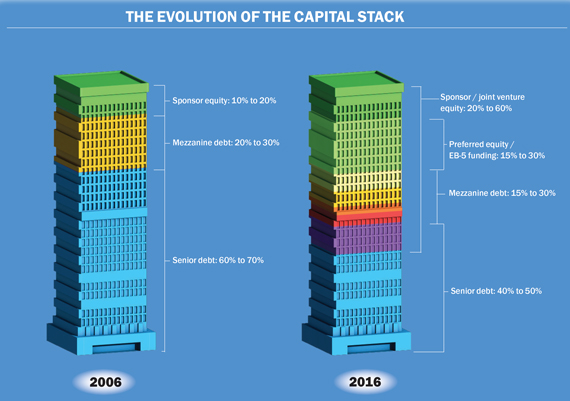Trending
Stacked against the odds
The capital stack for condo construction is becoming more layered than ever

When it comes to condominium construction, the many tiers of equity and debt needed to get the job done have become all the more complicated.
As the amount of money that U.S. banks are willing to lend to developers has decreased tremendously in the past year — especially for ultra-luxury projects — those looking to build condos from the ground up must cobble together financing from a wider array of alternative sources. That includes additional equity partners, high-yield debt funds, hedge funds and foreign investors.
Extell Development [TRDataCustom], for example, is seeking $190 million in EB-5 financing for its 95-story Central Park Tower at 217 West 57th Street and $200 million for its 80-story One Manhattan Square project at 252 South Street.
“The bank world is definitely gun-shy about condos at the moment,” said Richard Sussman, a real estate attorney with Rosenberg & Estis. “I don’t think anyone thinks building $5,000-a-square-foot condo units is the thing to do now.”
Industry players across the board have been sounding the alarm over softness at the top of New York’s condo market in recent months. An analysis of data from Olshan Realty’s weekly market report showed that sales volume of luxury condos in Manhattan dropped 25 percent in the first 20 weeks of 2016, compared to the same time last year.
 This means an even more complex capital stack for many of those projects — one that requires more tranches of sponsor equity, mezzanine debt, preferred equity, EB-5 funds and even the prospect of crowdfunding. Morrison & Foerster’s Mark Edelstein told The Real Deal that developers are lucky to get banks to cover 50 percent of the cost of a condo project and are often expected to put down more of their own money than in previous years.
This means an even more complex capital stack for many of those projects — one that requires more tranches of sponsor equity, mezzanine debt, preferred equity, EB-5 funds and even the prospect of crowdfunding. Morrison & Foerster’s Mark Edelstein told The Real Deal that developers are lucky to get banks to cover 50 percent of the cost of a condo project and are often expected to put down more of their own money than in previous years.
Compare this to before the market collapsed in 2008, and the typical stack for condo construction takes on a totally different look. In 2006, banks were routinely lending between 60 and 70 percent of the cost of a condo project, and in some cases more than 75 percent. Mezzanine loans often took the loan-to-cost (LTC) ratio up to 90 percent and then developers covered the remaining 10 percent or so with equity, Edelstein said.
LTC levels dropped in 2008 and 2010, and many condo projects stalled during the recession as traditional bank financing became virtually unavailable for the bulk of developers. Then, as the market recovered and New Yorkers saw residential prices begin to climb dramatically, the LTC on many projects ticked back up — reaching 50 to 55 percent in 2011 and 2012, and up to 65 percent in 2014 and 2015.
Now, in mid-2016, those ratios have once again changed. While some developers with particularly deep pockets can fill in the gap left by the recent retreat of banks, others have to find alternatives that are often more expensive and less secure. In the most complex scenarios, the financing for a condo project can include upward of four layers of mezzanine debt and preferred equity, among other sources of funding.
“The larger the deal, the more layers you’ll need to get up to the desired leverage point,” said Drew Fletcher, president of New York-based debt and equity brokerage the Greystone Bassuk Group. “The more specialized the asset type, the more complicated the capital stack.”




